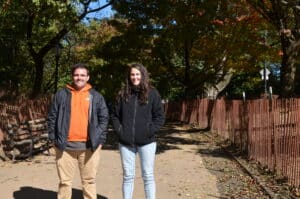Soil Superfood: Biochar Helps Landscapes Thrive
August 13, 2025
Prospect Park Alliance’s Design and Construction team is constantly innovating to sustain, restore and advance Brooklyn’s Backyard: whether making a green park greener, crafting award-winning designs, and most recently, implementing a new method to boost the health of the park’s soil. In Fall of 2024, you may have spotted the Alliance at work on an innovative technique to help the park’s soil thrive around the newly restored path near the Garfield Entrance to Prospect Park. The team added an organic type of charcoal, called “biochar,” to the area to boost the impact of the team’s work to “decompact” soil and help the landscape thrive. Biochar acts as a nutrient-rich soil superfood which allows the soil to become more porous and facilitates the absorption of oxygen and nutrients. In just 9 months since first adding biochar to the area, the site has already seen improvements with stormwater management, soil enhancement and tree health.

Trees near the Garfield entrance before decompaction in Fall 2024, left. The same area with lush grass and leafed-out trees in Summer 2025, right.
As millions of park-goers explore Brooklyn’s backyard each year, soil can become compacted, which can prevent trees from absorbing retaining the water and nutrients that they need. This area had become compacted over time, so upon completing the path restoration, the team set to “decompact” the ground with the special addition of biochar. “Without damaging roots, we use an air-powered tool to create pockets in the root area of the tree. This creates a void that can be filled with compost, or in this case, top soil mixed with biochar,” says Prospect Park Alliance Construction Supervisor, Mathew Hall. “This gives the tree’s roots the chance to grow longer, wider and even laterally.”
“Biochar is a very fine type of charcoal created from heating leaves, branches, and other natural matter at a really high temperature without oxygen,” explained Prospect Park Alliance Landscape Architect, Jillian Pagano. “An example of how this organic charcoal could occur naturally is after a forest fire, where natural debris could smolder on the ground beneath a layer of ash without oxygen. At that high of a temperature, all of the gases and nutrients released become locked into a solid that naturally decomposes into soil and enhances the soil’s ability to retain water.” This makes biochar an excellent addition to newly planted landscapes in areas where the soil needs some extra support to remain healthy.

Alliance Construction Supervisor, Mathew Hall (left), and Alliance Landscape Architect, Jillian Pagano (right) share about the early signs of widespread benefits of Biochar in the park.
Thanks to the porous makeup of biochar, the area is now set up to better retain storm water and the team has already observed a decrease in rain water pooling. “By incorporating biochar instead of the usual soil mixture, our goal is to create more longevity in the decompaction process throughout the park,” says Hall. Pagano adds, “If success is seen in the long term–in 5 years as opposed to just 1 year–then we can look to other projects where adding biochar to the decompaction process could create more nutrients and water retention capabilities in the soil.”
Since the initial addition of biochar to this area, the Alliance’s Landscape Management team has planted witchhazel, winterberry, azaleas and spicebush shrubs, some of which first bloomed in spring and are continuing to thrive this summer. The grass has returned to the area and trees have leafed out–a sign of health all around!
Interested in lending a hand to Prospect Park Alliance on projects like these? The best way to help is by remembering to Be a Park Champion. Staying on paths, respecting fencing, keeping dogs on leash outside of designated hours and areas, and cycling only on the park drive helps keep the park’s soil healthy for our landscapes to thrive.